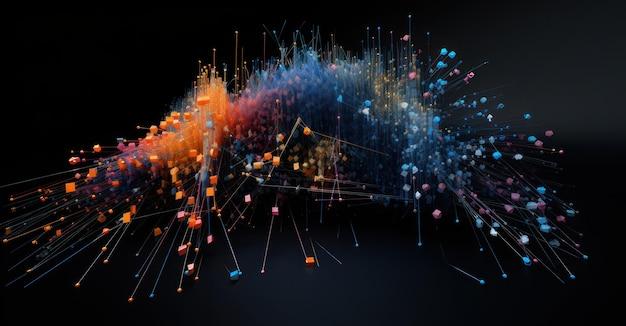Welcome to 2023, where data analysis has become an integral part of decision-making in various industries. In the vast realm of data visualization, scatter plots are often used to gain insights into relationships between different variables. But have you ever wondered what those intriguing clusters in scatter plots actually represent?
In this blog post, we will delve into the world of scatter plot clusters, unraveling their significance in data analysis. We’ll explore their definition, characteristics, and the tools used to identify and interpret them. Along the way, we’ll also touch upon the concept of clustering in general, revealing its broader applications beyond scatter plots.
So, whether you’re a data enthusiast, a business owner, or simply curious about data visualization, join us on this journey to unlock the mysteries hidden within scatter plot clusters. Let’s dive in!

What are Clusters in Scatter Plots?
Clusters in scatter plots are like the popular kids in high school—they stick together and stand out from the rest of the crowd. These clusters, much like cliques, are groups of data points that are closely packed together on a scatter plot, forming distinct patterns that catch the eye.
Unraveling the Mystery of Clusters
Unlike finding your place in the cafeteria, deciphering clusters in scatter plots is not an art reserved for the chosen few. Anyone can unveil their secrets with a little data exploration. By analyzing a scatter plot, you can identify clusters and gain insights into the underlying trends and relationships in the data.
Why Clusters Form
Clusters in scatter plots arise from the inherent structure of the data. When data points share similar characteristics or variables, they tend to gravitate towards each other on the plot. These clusters can represent distinct groups or categories within the data, allowing us to see patterns that might not be apparent at first glance.
Cluster Types and Significance
Clusters in scatter plots can come in all shapes and sizes, just like the diverse range of characters you encounter in high school. Some clusters are tightly packed, while others may have a looser, more spread-out formation. The number of clusters can also vary, from just a few to many.
Identifying and understanding the different cluster types can be a game-changer in data analysis. Clusters can provide valuable insights, such as identifying target customer segments, detecting anomalies or outliers, or uncovering hidden patterns that can guide decision-making processes.
Unleashing the Power of Clusters
Clusters in scatter plots are not just visually appealing; they serve a purpose in data analysis. By looking for and analyzing clusters, you can gain a deeper understanding of your data, uncover trends, relationships, and patterns, and make data-driven decisions with confidence.
To effectively work with clusters, you can employ different techniques such as cluster analysis algorithms like K-means or hierarchical clustering. These methods allow you to automatically identify and group data points based on their similarities, making the process of spotting and analyzing clusters much more efficient and systematic.
Clusters in scatter plots are like treasures waiting to be discovered. They hold valuable information and insights within data, allowing us to see patterns, relationships, and trends that might otherwise remain hidden. So, the next time you come across a scatter plot, keep an eye out for those standout clusters—because they just might hold the key to unlocking the untold stories of your data.

FAQ: What are clusters in scatter plots?
Welcome to our FAQ section on clusters in scatter plots! In this comprehensive subsection, we’ll explore some common questions about clusters, shedding light on what they are and why they matter in the world of data analysis. So, let’s dive in and unravel the mysteries of clusters in scatter plots!
What is the purpose of clustering and why do we need it
Clustering plays a vital role in data analysis by helping us identify patterns and groups within datasets. It’s like finding a hidden herd of sheep in a vast field – clusters help us bring order to the chaotic world of data. By grouping similar data points together, clustering enables us to gain valuable insights, make data-driven decisions, and discover meaningful relationships that might have otherwise gone unnoticed.
How do you identify a cluster in a scatter plot
Ah, the unmistakable clusters in scatter plots! They are like islands in a vast ocean of data points. To identify clusters, you simply need to look for groups of points that are tightly packed together while being distinctly separated from other groups.
Think of it as spotting groups of friends at a crowded party. Each cluster represents a group having a conversation (or maybe plotting world domination, who knows?). The closer the friends are to each other, the tighter the cluster, making it easier to spot amidst the sea of people.
What are the applications of clustering
Clusters have countless applications across various fields. From customer segmentation in marketing to image recognition in computer vision, clustering helps us make sense of complex data. It aids in identifying fraud patterns in financial transactions, grouping similar documents together in natural language processing, and even analyzing astronomical data to uncover hidden celestial clusters. The possibilities are truly endless!
What are the different clustering techniques
Ah, the toolkit of a data analyst is filled to the brim with clustering techniques. There are several popular methods, each with its own strengths and weaknesses. Some of the most common techniques include k-means clustering, hierarchical clustering, DBSCAN, and spectral clustering. Each method has its own unique approach to grouping data points, ensuring we have a wide array of options at our disposal.
Are there any clusters or outliers in the scatter plot
Ah, outliers! The rebels of the data world. While clusters represent the popular kids at the party, outliers stand out like a penguin in the Sahara. These misfits are data points that don’t quite fit within any particular cluster. They can be fascinating anomalies or pesky errors that can wreak havoc on our conclusions. Identifying outliers is crucial in cleaning up data and ensuring accurate analysis.
What is the best clustering method
Ah, the age-old question of the best clustering method. It’s like asking for the best flavor of ice cream – opinions abound! The answer really depends on the nature of your data and the specific problem at hand. Each clustering method has its own strengths and weaknesses, making it important to consider various factors before choosing the most suitable technique. So, rather than seeking the definitive answer, embrace the journey of exploring different methods and discovering what works best for your unique data.
What is the difference between a node and a cluster
Ah, the curious case of nodes and clusters! Let’s put on our detective hats and solve this mystery. In simple terms, a node refers to an individual data point, while a cluster represents a group of nodes that are similar or closely related to each other. Think of nodes as the building blocks and clusters as the beautifully structured communities they form. So, while a node may stand alone, a cluster flourishes with the camaraderie of its members.
What is cluster configuration
Ah, the importance of organization! Cluster configuration refers to the setup or arrangement of data points within a cluster. It defines how the points within a cluster are structured and related to each other. Just like arranging your books alphabetically or by genre on a shelf, cluster configuration helps us understand the internal dynamics and relationships within a group of data points. It’s all about making sense of the chaos and unlocking the hidden secrets within clusters.
What is a quorum in a cluster
Ah, a word often heard in the world of clustering – quorum! In the context of clusters, a quorum refers to the minimum number of nodes or participants required for a cluster to function properly. It’s like a group study session – without enough members present, the study session falls apart, and knowledge remains hidden. The concept of a quorum ensures that there are enough nodes actively participating within a cluster to maintain its integrity and achieve the desired outcomes.
What is cluster interconnect
Ah, the invisible threads connecting the nodes! Cluster interconnect refers to the underlying network connections between nodes within a cluster. It’s like the secret passages connecting different rooms in a castle – allowing the nodes to communicate, share information, and work together seamlessly. The performance and efficiency of cluster interconnect play a crucial role in the overall effectiveness of a cluster, making it an essential component to consider in cluster design and implementation.
What is the maximum number of network bandwidth per instance on VPC gen2 on IBM Cloud
Ah, the quest for network bandwidth! While we could often use an infinite amount of bandwidth to satisfy our data needs, the maximum number of network bandwidth per instance on VPC gen2 on IBM Cloud is subject to specific configurations and limitations. To ensure you have the most up-to-date and accurate information, it’s best to consult the IBM Cloud documentation or reach out to their support team for the latest bandwidth specifications.
And there you have it – a comprehensive FAQ section on clusters in scatter plots! We hope this subsection has shed light on the intriguing world of clustering, helping you unravel the mysteries and discover the power of clusters in analyzing data. If you find yourself lost in the wilderness of data again, remember that clusters are your trusted companions, ready to guide you on your data-driven journey!
Now, go forth and analyze with confidence, dear data adventurer! 🚀
